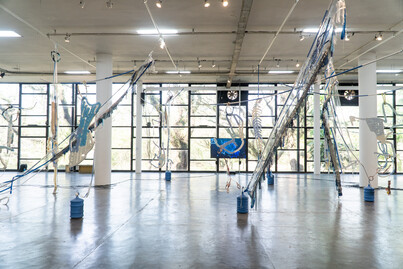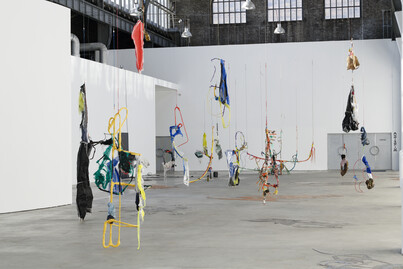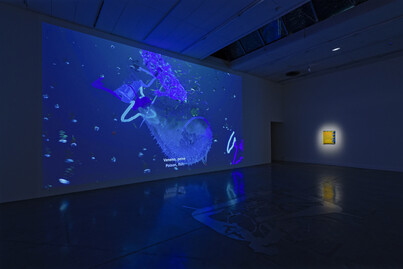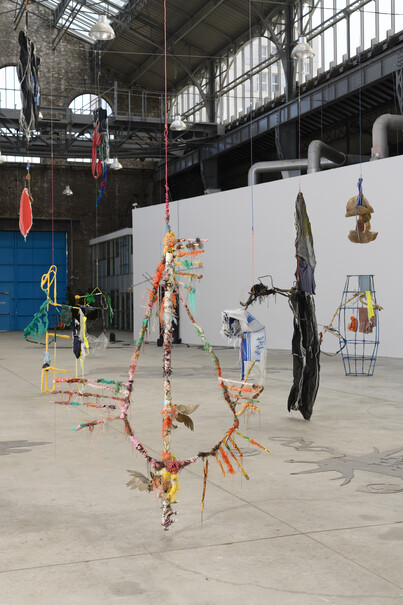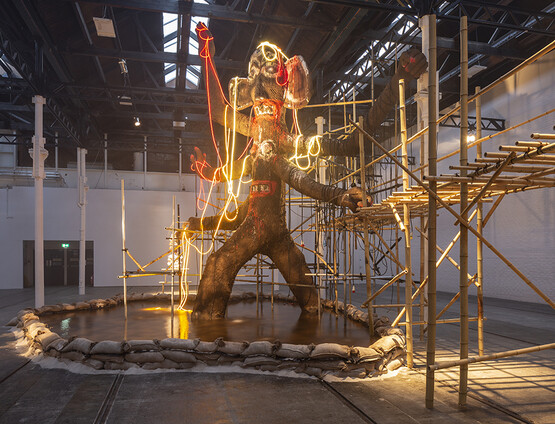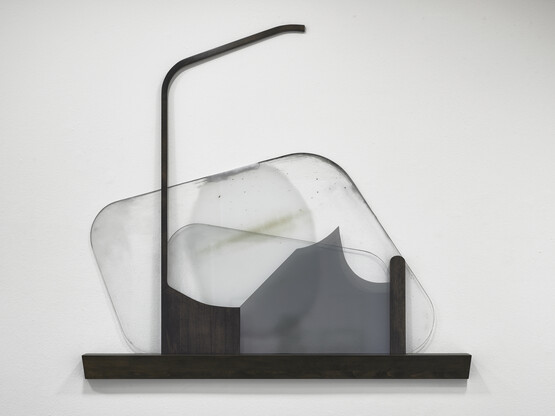
Julien Creuzet’s buried spiders at Venice
by Andrew Hodgson
Articles /
Artist profile
• 05.04.2024
When the French artist Julien Creuzet (b.1986) announced his intentions for the French Pavilion at the 60th Venice Biennale (20th April–24th November 2024), he did so by invoking his childhood memories of searching for the Avicularia versicolor, the Martinique red tree spider in the tropical forests of the north of the island.1 Creuzet would look for the spider with his brother and father, attempting to locate it among the leaves and decomposing foliage on the forest floor. Occasionally they would see the spider, but other times they would be mistaken, or simply imagine it. Now, the artist comes across the elusive creature in his dreams, and in his recollections of growing up on the island. Creuzet, who is of Caribbean heritage, was born in France and moved to Martinique when he was four years old. He returned to study and work in Paris at the age of twenty, and now lives in the suburb of Montreuil and teaches at the Beaux-Arts de Paris. During the press conference Creuzet highlighted this cultural duality and how it informs his practice, stating that this year the pavilion will indeed represent France, but seen through the lens of the overseas territory of Martinique.
Although Creuzet’s exact plans for the Biennale remain undisclosed – he has previously stated that ‘art is there to be felt […] an explanation means nothing’ – the metaphorical tract he read for the announcement indicates a development of his interest in the tropes and themes of Pan-Africanism, the decolonisation of French art and an attempt to wrangle with the xenophobia deeply rooted in French culture.2 As such, Creuzet’s appointment generates a series of confrontations between the artist and the national identity that he has been selected to represent. The announcement was broadcast from the Maison Édouard Glissant in Martinique, where the artist was undertaking an artist residency, and the interviewer declared that, for the first time, the ‘road to Venice’ was set out upon from France’s neglected overseas territories.3 This choice shines a light on the complexities inherent in the relationship between the French mainland and the island of Martinique, and the historical and contemporary issues that Creuzet’s work often seeks to redress.
Creuzet’s practice encompasses various mediums, including poetry and performance FIG.1 FIG.2, although he is primarily known for his sculpture and video work FIG.3 FIG.4. His wide-ranging forms and materials are underpinned by an intimate engagement with language, providing a semantic shape to the otherwise fluid nature of his œuvre. The artist approaches words as both an oppressive system that controls what and how we communicate, and as material things that can be deconstructed and reformed through poetry. For example, the plasticity – both formal and linguistic – of his poetry can be identified in last time and big evening and if we say goodbye to the trauma nightmare. one last time under the headlights on the big night, the big jump, we said see you tomorrow under other skies, in the air before contact with the sea, we loved each other. (dernière fois) FIG.5. The artist’s use of repurposed materials – and the sense of disrupted visual and linguistic lexica, of identification not with a place but the ocean in-between that they elicit – gestures towards what he refers to as a sense of being ‘uprooted’ historically, literally, symbolically and culturally.4
In August 2020 Creuzet staged a performance titled Playlist for a colonial monument on the steps of Gare de Marseille-Saint-Charles, the grand staircase that opens out onto the city from the main train station. It frames the view further still, beyond the buildings and streets rolling out below, onto the Mediterranean Sea. The station connects Marseille to Paris, and therefore the French mainland to the rest of the world. In the colonial era it was a gateway to France’s holdings on other continents, and the staircase is lined with monuments celebrating the country’s early-twentieth century imperial glories in Africa and Asia. Rather than address the sculptures and the colonial past of the city directly, the artist walked the staircase and played ‘ten pop songs to listen to, when words are no longer possible’.5
The performance was staged a month after the long-decapitated statue of Joséphine Bonaparte in Fort-de-France, the capital of Martinique, was finally torn down during a wave of defacements and removals of monuments, in both Europe and the United States, dedicated to slavers. This proactive reconfiguration of public spaces utilised practices of cultural intervention employed by the Black Lives Matter movement in the wake of George Floyd’s murder. This instance in Martinique is a notable expression of dissent within a self-described ‘colour-blind’ republic, in which it is illegal to collect data on ethnicity and race. France’s complex relationship to its past is perhaps most clearly edified by the remains of colonial exhibitions – including ‘ethnological displays’, also known as human zoos – of the last century, which fester at the periphery of Paris in the Bois de Vincennes. As such, France’s legacy of empire pervades in a sort of silent tension between colonialism’s affective past and present, a sort of cultural stasis with which Creuzet’s work engages.
Creuzet recently returned to this theme in a conversational tour of the Musée du Louvre, Paris, with Hans Ulrich Obrist, in which he led Obrist to Sacre de l’empereur Napoléon 1er et couronnement de l’impératrice Joséphine dans la cathédrale Notre-Dame de Paris, le 2 décembre 1804 (1805–07) by Jacques-Louis David (1748–1825). Hanging in the museum’s grand red room, this vast canvas represents the coronation of Empress Joséphine. Born in Martinique to a family of slave owners, Joséphine is believed to have played a part in lobbying her husband Napoleon to re-establish slavery on the island in 1802. In highlighting this painting among a collection that forms a key facet of French national identity, Creuzet performs a kind of cultural intervention through the retelling of such staid symbols. Whereas the painting of Joséphine remains untouched in the Louvre, as the artist noted in conversation with Obrist, all that remains of Joséphine’s statue at Fort-de-France is the pedestal: ‘the pedestal today is a place for collecting compost’.6
Such themes will also underpin Creuzet’s presentation in Venice, which he has described as a development of his recent exhibitions at the 35th Bienal de São Paulo, and Magasin CNAC, Grenoble. Evoking the principles of Pan-Africanism, Creuzet’s installation in São Paulo was titled ZUMBI ZUMBI ETERNO, referencing the Creole originator of the term ‘zombie’, and the seventeenth-century Afro-Brazilian freedom fighter Zumbi dos Palmares, who was king of a society of freed slaves in Palmares in the north of Brazil. The works included AI-generated images of statues FIG.6 that evoke an Afrofuturism inspired by the artist’s research into André Breton’s collection of African statues and masks. These were shown alongside the artist’s hanging sculptures, which create organic lines, forms and patterns from strips of coloured plastic wrapped around metal FIG.7. These objects conjure a Caribbean imaginary, with the carnivalesque hues contrasting starkly against the windows and white walls of the exhibition space. Here, the artist seeks to reclaim the term zombie from its deathly connotations and return its original Haitian vodou meanings of vitality and life beyond death.
Creuzet’s current exhibition Oh telephone, oracle noir (…) at Magasin CNAC (17th November 2023–26th May 2024) FIG.8 FIG.9 is a vast monograph of his work from 2015 onwards and acts as a prelude to his project for Venice. Here again, the symbols, light and forms of the Martinique of Creuzet’s childhood memory fill the space. His sculptural assemblages incorporate cut-away and washed-up lobster pots and fishing nets FIG.10, which are splayed into new forms by the sea, the effect of time on the artist’s memory and his hands upon the material. The works take on a sense of the flotsam and jetsam of Creuzet’s Montreuil–Martinique imaginary – the artist’s own editing and rearranging of a sublime archipelago. Creuzet provokes disorientation in the viewer, as they encounter a world of far-reaching, reintegrated signs that create a form of creole visual language: a sense of cross-cultures that he twines into the objects themselves.
The Venice Biennale brings this dynamic into direct and stark confrontation with France’s colonial past. The French pavilion was built in 1912 as a grand white cube, similar to those constructed across Europe for world fairs and colonial exhibitions with the goal of proclaiming France’s sociocultural importance on the world stage and projecting the country’s imperial grandeur. Similarly, the Giardini was created between 1808 and 1812 at the behest of Napoleon in his redesign of Venice following his conquest of the city-state. In this sense, ‘the road to Venice’ begins and ends in the history of French colonialism, and Creuzet’s personal and artistic interaction with that history and its persistence in contemporary society.
As for the ‘feel’ that Creuzet plans for Venice, he seeks to create ‘a total visual, audio and olfactory experience’ drawing from the ocean and landscapes of Martinique.7 The pavilion will include eighty sculptures and six video works, which revolve around the memories and dreams of searching for the Avicularia versicolor, found only in the northern reaches of Martinique. It is a shy creature that can be difficult to pin down, preferring to ensconce itself deep in the undergrowth. This sense of seeking – in the forest and in dreams – will inform the core experience of the French Pavilion. In reimagining French Afro-Caribbean culture and its material symbols, as seen through childhood memories and dreamscapes, Creuzet hopes to reinvent the pavilion space. In doing so, he seeks to draw the visitor into a hunt for the elusive, the hidden and the buried among the tropical forests of his own imaginary.





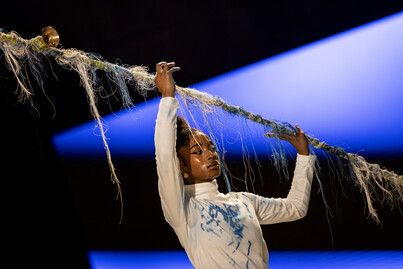
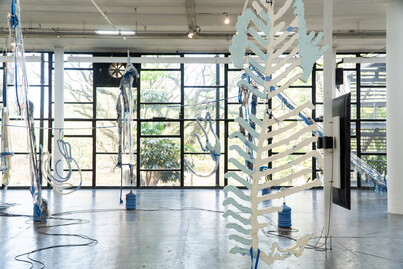
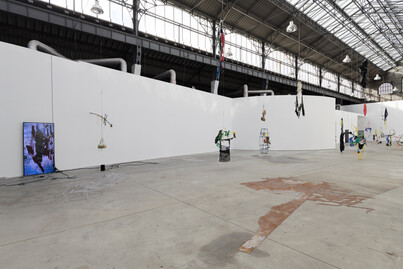
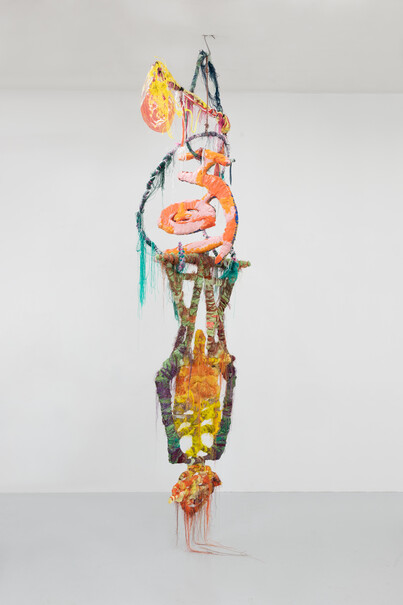
.jpg)
